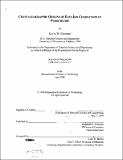Crystallographic origins of fast-ion conduction in pyrochlore
Author(s)
Eberman, Kevin W. (Kevin Wilmot), 1971-
DownloadFull printable version (9.898Mb)
Advisor
Bernhardt J. Wuensch.
Terms of use
Metadata
Show full item recordAbstract
We have examined the crystallographic origins of fast-ion conduction in oxides with the pyrochlore structure-type, ideally A2B2O7, a superstructure of (A,B)20 3.5 defect fluorite-like array. These materials have technological promise for use in electrochemical devices such as oxygen sensors and solid-oxide fuel-cells. The pathway for ion conduction proposed by several authors has been a jump between equivalent nearest-neighbor oxygen sites through the tetrahedral edges of the relatively-immobile cation array. Substitution of a third cation species in slid-solution in the B site, A2(B-yB'y)2O7, results in a marked change in the structure and properties of the materials which is not fully understood. As the average radius of the cations occupying the B-site increases (with changing composition) towards that of the larger average radius of the cations occupying the Asite, a tendency for increasing disorder has been observed, where complete disorder corresponds to the fluorite structure. A decrease in Frenkel-defect formation-energy and an increase in the migration enthalpy accompanies the disordering. We have executed several studies of pyrochlore structures employing neutron and x-ray powder diffraction. In particular, we have focused on high-temperature in-situ experiments that should better correspond to the structure for which the conductivity measurements were made at elevated temperature ...
Description
Thesis (Ph.D.)--Massachusetts Institute of Technology, Dept. of Materials Science and Engineering, 1998. Includes bibliographical references (p. 129-132).
Date issued
1998Department
Massachusetts Institute of Technology. Department of Materials Science and EngineeringPublisher
Massachusetts Institute of Technology
Keywords
Materials Science and Engineering